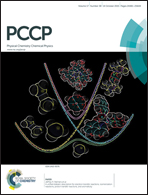Atmospheric chemistry of (CF3)2C![[double bond, length as m-dash]](https://www.rsc.org/images/entities/char_e001.gif) CH2: OH radicals, Cl atoms and O3 rate coefficients, oxidation end-products and IR spectra†
CH2: OH radicals, Cl atoms and O3 rate coefficients, oxidation end-products and IR spectra†
Abstract
The rate coefficients for the gas phase reactions of OH radicals, k1, Cl atoms, k2, and O3, k3, with 3,3,3-trifluoro-2(trifluoromethyl)-1-propene ((CF3)2C![[double bond, length as m-dash]](https://www.rsc.org/images/entities/char_e001.gif) CH2, hexafluoroisobutylene, HFIB) were determined at room temperature and atmospheric pressure employing the relative rate method and using two atmospheric simulation chambers and a static photochemical reactor. OH and Cl rate coefficients obtained by both techniques were indistinguishable, within experimental precision, and the average values were k1 = (7.82 ± 0.55) × 10−13 cm3 molecule−1 s−1 and k2 = (3.45 ± 0.24) × 10−11 cm3 molecule−1 s−1, respectively. The quoted uncertainties are at 95% level of confidence and include the estimated systematic uncertainties. An upper limit for the O3 rate coefficient was determined to be k3 < 9.0 × 10−22 cm3 molecule−1 s−1. In global warming potential (GWP) calculations, radiative efficiency (RE) was determined from the measured IR absorption cross-sections and treating HFIB both as long (LLC) and short (SLC) lived compounds, including estimated lifetime dependent factors in the SLC case. The HFIB lifetime was estimated from kinetic measurements considering merely the OH reaction, τOH = 14.8 days and including both OH and Cl chemistry, τeff = 10.3 days. Therefore, GWP(HFIB,OH) and GWP(HFIB,eff) were estimated to be 4.1 (LLC) and 0.6 (SLC), as well as 2.8 (LLC) and 0.3 (SLC) for a hundred year time horizon. Moreover, the estimated photochemical ozone creation potential (εPOCP) of HFIB was calculated to be 4.60. Finally, HCHO and (CF3)2C(O) were identified as final oxidation products in both OH- and Cl-initiated oxidation, while HC(O)Cl was additionally observed in the Cl-initiated oxidation.
CH2, hexafluoroisobutylene, HFIB) were determined at room temperature and atmospheric pressure employing the relative rate method and using two atmospheric simulation chambers and a static photochemical reactor. OH and Cl rate coefficients obtained by both techniques were indistinguishable, within experimental precision, and the average values were k1 = (7.82 ± 0.55) × 10−13 cm3 molecule−1 s−1 and k2 = (3.45 ± 0.24) × 10−11 cm3 molecule−1 s−1, respectively. The quoted uncertainties are at 95% level of confidence and include the estimated systematic uncertainties. An upper limit for the O3 rate coefficient was determined to be k3 < 9.0 × 10−22 cm3 molecule−1 s−1. In global warming potential (GWP) calculations, radiative efficiency (RE) was determined from the measured IR absorption cross-sections and treating HFIB both as long (LLC) and short (SLC) lived compounds, including estimated lifetime dependent factors in the SLC case. The HFIB lifetime was estimated from kinetic measurements considering merely the OH reaction, τOH = 14.8 days and including both OH and Cl chemistry, τeff = 10.3 days. Therefore, GWP(HFIB,OH) and GWP(HFIB,eff) were estimated to be 4.1 (LLC) and 0.6 (SLC), as well as 2.8 (LLC) and 0.3 (SLC) for a hundred year time horizon. Moreover, the estimated photochemical ozone creation potential (εPOCP) of HFIB was calculated to be 4.60. Finally, HCHO and (CF3)2C(O) were identified as final oxidation products in both OH- and Cl-initiated oxidation, while HC(O)Cl was additionally observed in the Cl-initiated oxidation.
![Graphical abstract: Atmospheric chemistry of (CF3)2C [[double bond, length as m-dash]] CH2: OH radicals, Cl atoms and O3 rate coefficients, oxidation end-products and IR spectra](/en/Image/Get?imageInfo.ImageType=GA&imageInfo.ImageIdentifier.ManuscriptID=C5CP03840E&imageInfo.ImageIdentifier.Year=2015)

 Please wait while we load your content...
Please wait while we load your content...
![[double bond, length as m-dash]](https://www.rsc.org/images/entities/h2_char_e001.gif) CH2: OH radicals, Cl atoms and O3 rate coefficients, oxidation end-products and IR spectra
CH2: OH radicals, Cl atoms and O3 rate coefficients, oxidation end-products and IR spectra